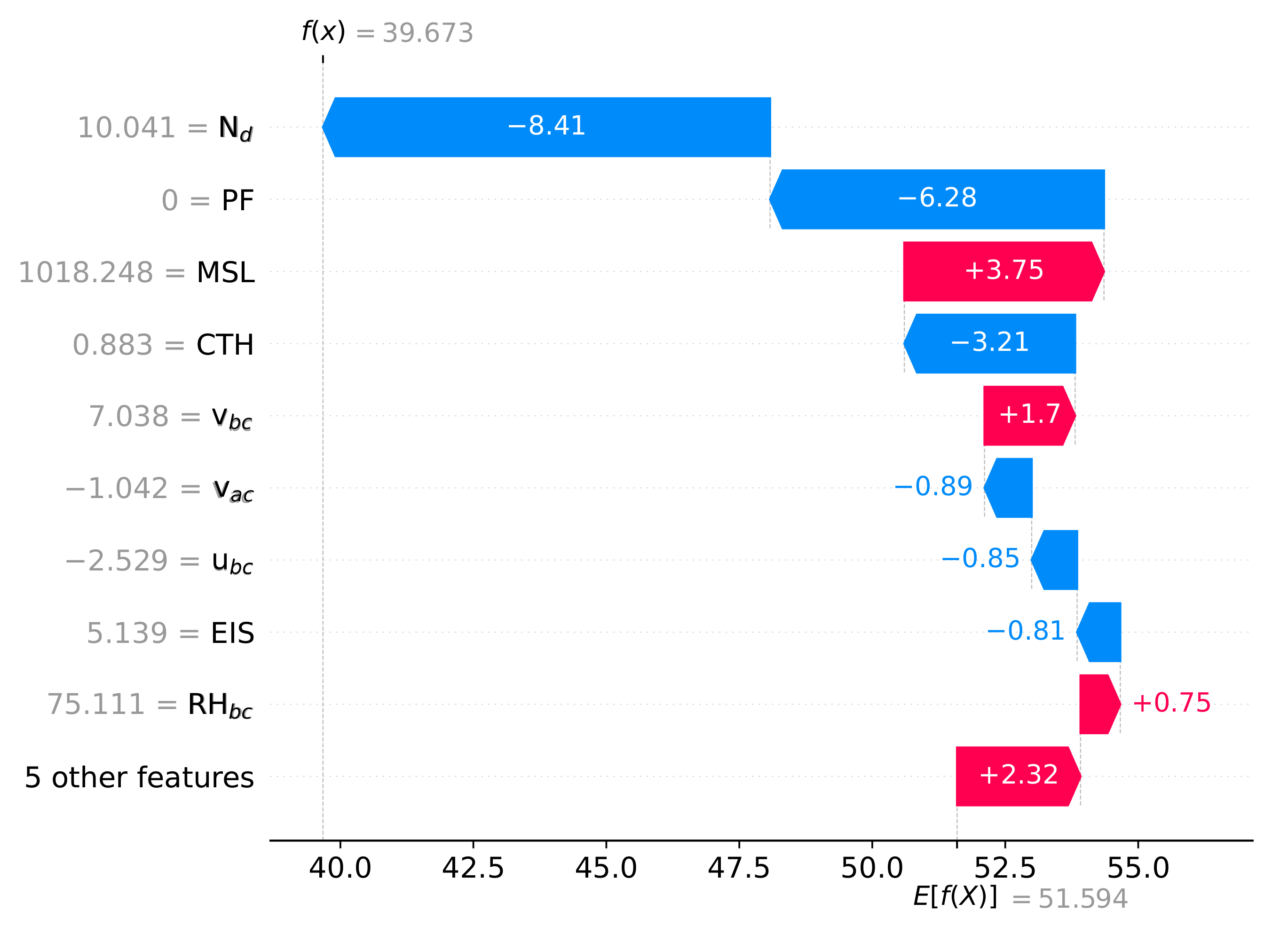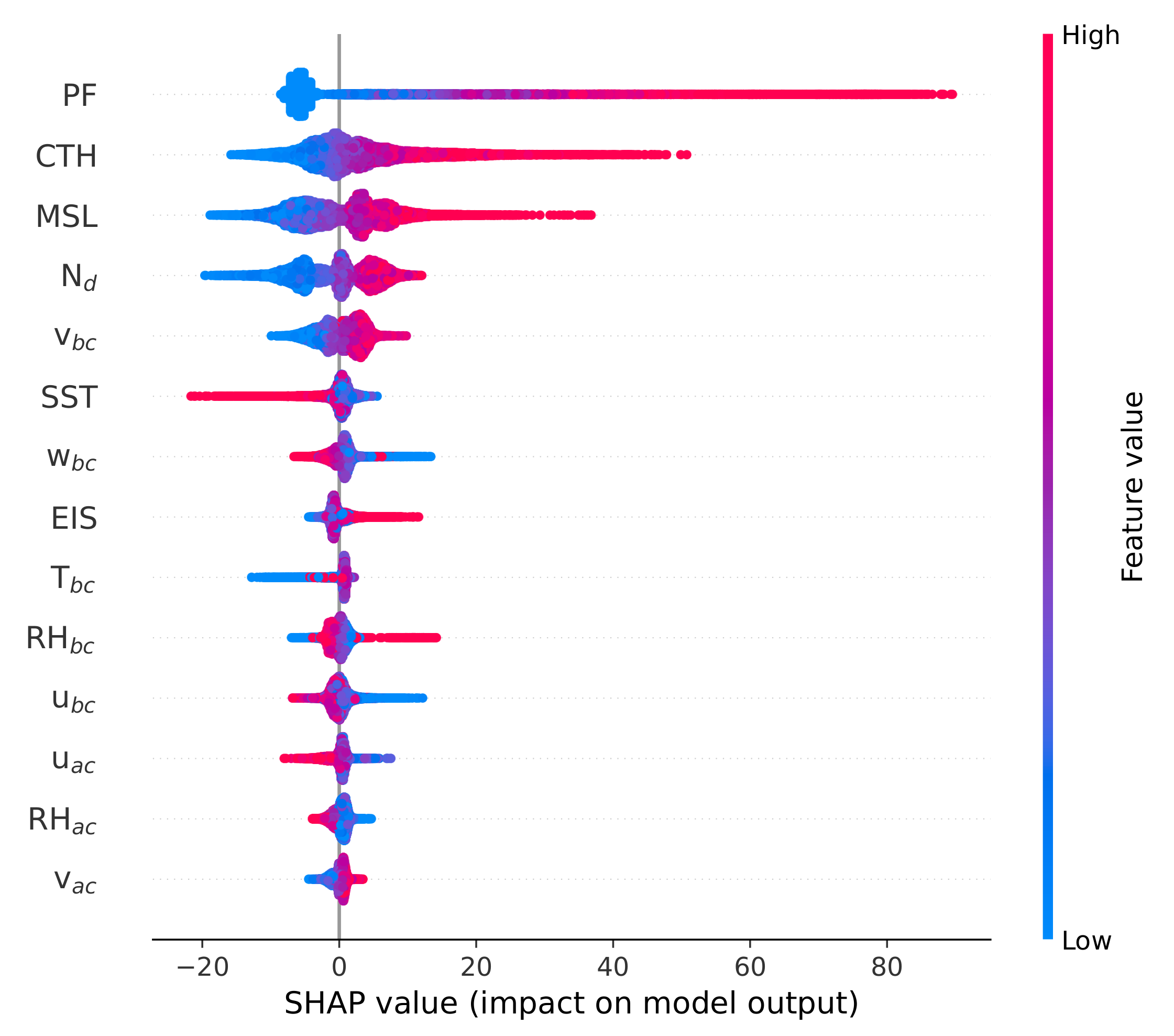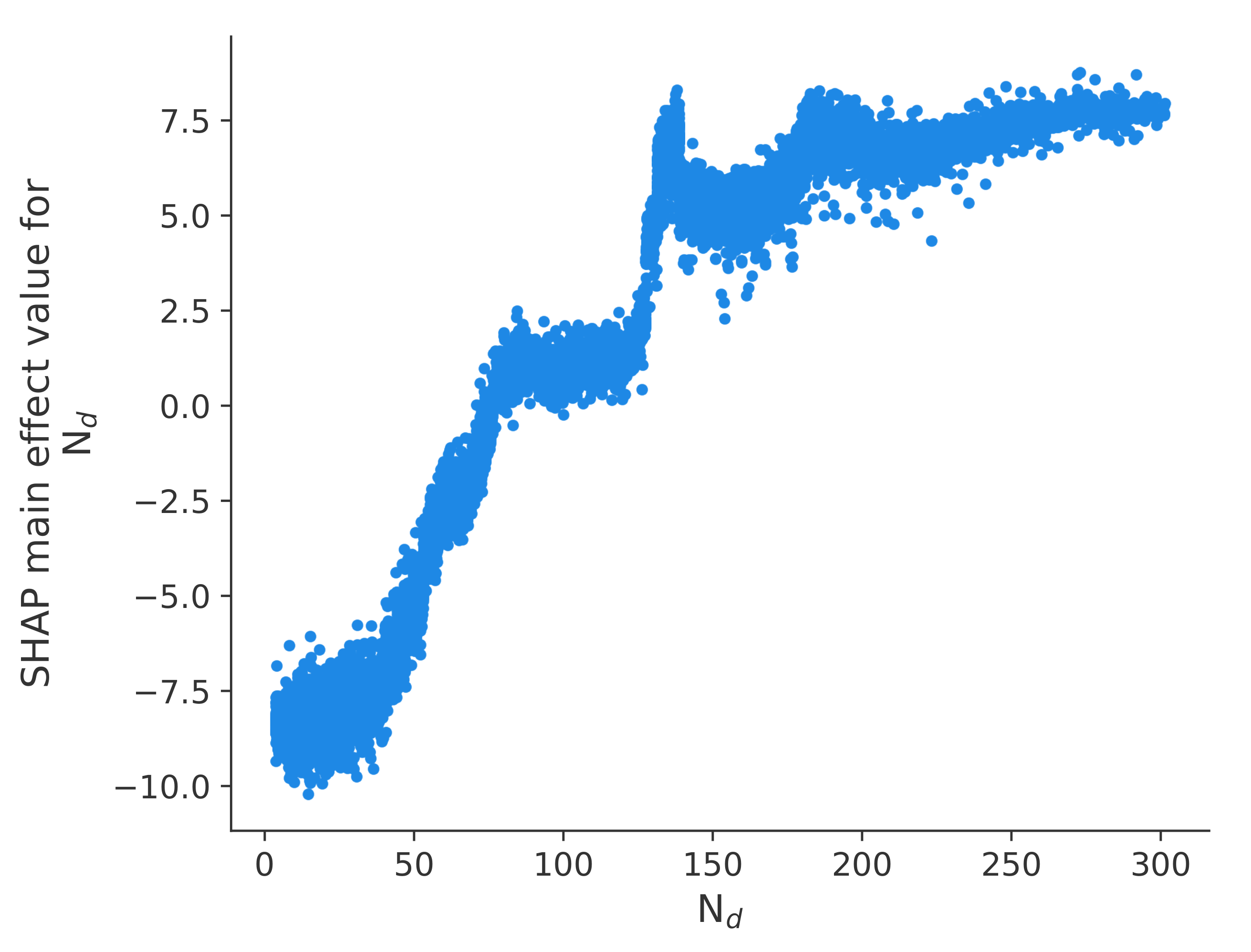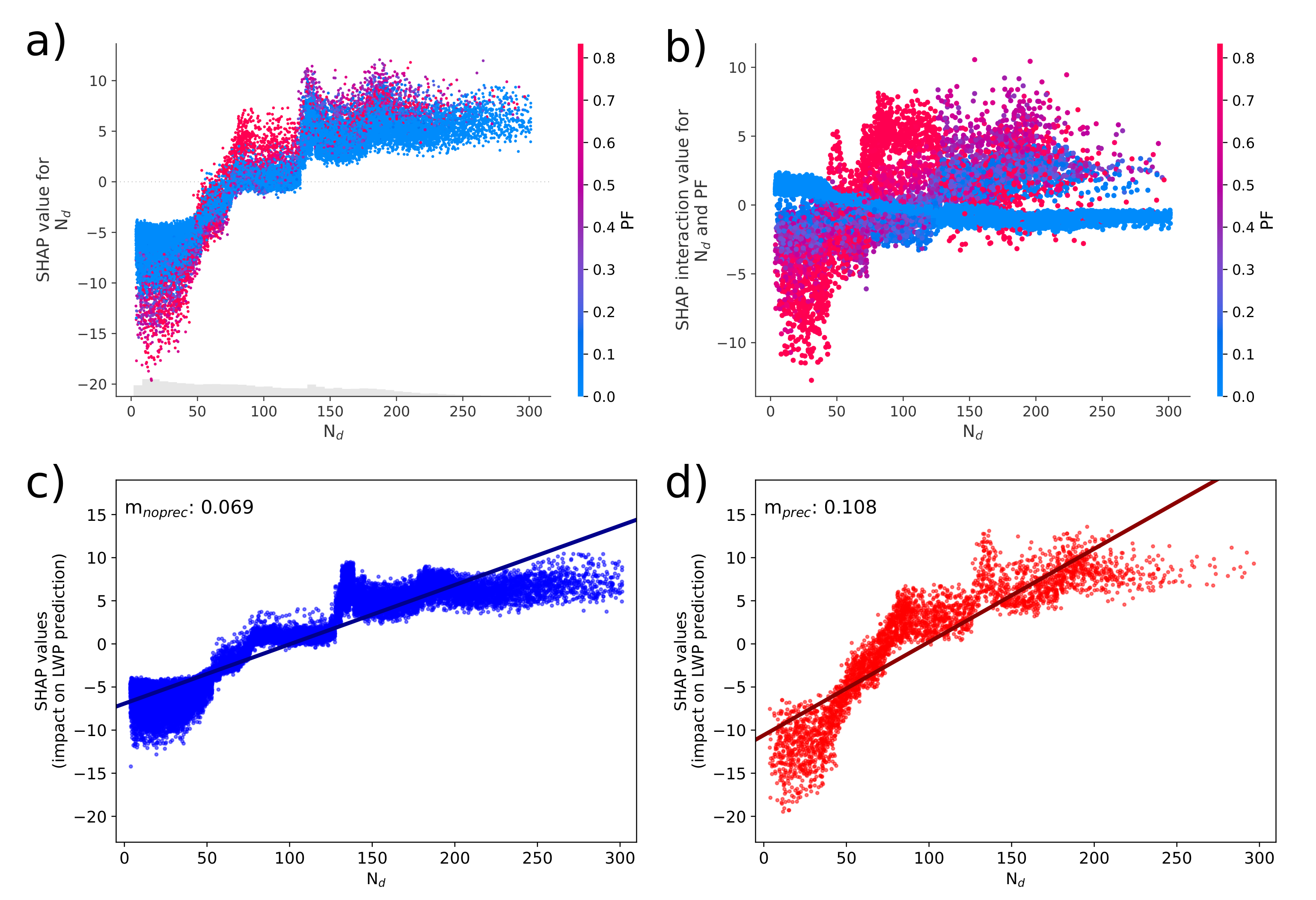Machine-Learning Based Analysis of Liquid Water Path Adjustments to Aerosol Perturbations in Marine Boundary Layer Clouds Using Satellite Observations
Abstract
1. Introduction
2. Materials and Methods
2.1. Data
2.2. Methods
3. Results and Discussion
4. Conclusions
- Within the machine-learning model, the most important cloud state parameters for the prediction of LWP are PF, CTH, and , while the most important environmental predictors are MSL, and SST. The machine-learning model is able to explain 70% of the observed variability in LWP (R2 = 0.70).
- Overall, a nonlinear but positive sensitivity of LWP to changes in is found, with a positive relationship at low values, which saturates at higher values. Unlike findings in a previous global study [18], the –LWP relationship at higher is not negative in the data set used here for the Southeast Atlantic.
- Marked differences are found in the sensitivity of LWP to changes in for precipitating and non-precipitating cloud groups. The stronger sensitivity is likely due to an amplified importance of precipitation suppression in situations that already develop some drizzle.
- Changes in SST show a direct influence on the –LWP relationship, with a decreased sensitivity of LWP to at higher SSTs. This may be attributed to increased evaporation-entrainment and deeper clouds due to the lower stability at higher SSTs.
Supplementary Materials
Author Contributions
Funding
Data Availability Statement
Acknowledgments
Conflicts of Interest
References
- Wood, R. Stratocumulus clouds. Mon. Weather Rev. 2012, 140, 2373–2423. [Google Scholar] [CrossRef]
- Klein, S.A.; Hartmann, D.L. The Seasonal Cycle of Low Stratiform Clouds. J. Clim. 1993, 6, 1587–1606. [Google Scholar] [CrossRef]
- Hartmann, D.L.; Ockert-Bell, M.E.; Michelsen, M.L. The Effect of Cloud Type on Earth’s Energy Balance: Global Analysis. J. Clim. 1992, 5, 1281–1304. [Google Scholar] [CrossRef]
- Latham, J.; Rasch, P.; Chen, C.C.; Kettles, L.; Gadian, A.; Gettelman, A.; Morrison, H.; Bower, K.; Choularton, T. Global temperature stabilization via controlled albedo enhancement of low-level maritime clouds. Philos. Trans. R. Soc. A Math. Phys. Eng. Sci. 2008, 366, 3969–3987. [Google Scholar] [CrossRef]
- Twomey, S. Pollution and the planetary albedo. Atmos. Environ. (1967) 1974, 8, 1251–1256. [Google Scholar] [CrossRef]
- Boucher, O.; Randall, D.; Artaxo, P.; Bretherton, C.; Feingold, G.; Forster, P.; Kerminen, V.M.; Kondo, Y.; Liao, H.; Lohmann, U.; et al. Clouds and aerosols. In Climate Change 2013: The Physical Science Basis. Contribution of Working Group I to the Fifth Assessment Report of the Intergovernmental Panel on Climate Change; Cambridge University Press: Cambridge, UK, 2013; pp. 571–657. [Google Scholar] [CrossRef]
- Zelinka, M.D.; Andrews, T.; Forster, P.M.; Taylor, K.E. Quantifying components of aerosol-cloud-radiation interactions in climate models. J. Geophys. Res. Atmos. 2014, 119, 7599–7615. [Google Scholar] [CrossRef]
- Heyn, I.; Block, K.; Mülmenstädt, J.; Gryspeerdt, E.; Kühne, P.; Salzmann, M.; Quaas, J. Assessment of simulated aerosol effective radiative forcings in the terrestrial spectrum. Geophys. Res. Lett. 2017, 44, 1001–1007. [Google Scholar] [CrossRef]
- Feingold, G. Modeling of the first indirect effect: Analysis of measurement requirements. Geophys. Res. Lett. 2003, 30, 1001–1007. [Google Scholar] [CrossRef]
- Quaas, J.; Boucher, O.; Lohmann, U. Constraining the total aerosol indirect effect in the LMDZ and ECHAM4 GCMs using MODIS satellite data. Atmos. Chem. Phys. 2006, 6, 947–955. [Google Scholar] [CrossRef]
- Quaas, J.; Arola, A.; Cairns, B.; Christensen, M.; Deneke, H.; Ekman, A.M.L.; Feingold, G.; Fridlind, A.; Gryspeerdt, E.; Hasekamp, O.; et al. Constraining the Twomey effect from satellite observations: Issues and perspectives. Atmos. Chem. Phys. 2020, 20, 15079–15099. [Google Scholar] [CrossRef]
- Andersen, H.; Cermak, J. How thermodynamic environments control stratocumulus microphysics and interactions with aerosols. Environ. Res. Lett. 2015, 10, 024004. [Google Scholar] [CrossRef]
- Andersen, H.; Cermak, J.; Fuchs, J.; Schwarz, K. Global observations of cloud-sensitive aerosol loadings in low-level marine clouds. J. Geophys. Res. Atmos. 2016, 121, 12936–12946. [Google Scholar] [CrossRef]
- Gryspeerdt, E.; Quaas, J.; Ferrachat, S.; Gettelman, A.; Ghan, S.; Lohmann, U.; Morrison, H.; Neubauer, D.; Partridge, D.G.; Stier, P.; et al. Constraining the instantaneous aerosol influence on cloud albedo. Proc. Natl. Acad. Sci. USA 2017, 114, 4899–4904. [Google Scholar] [CrossRef] [PubMed]
- McCoy, D.T.; Bender, F.A.M.; Mohrmann, J.K.C.; Hartmann, D.L.; Wood, R.; Grosvenor, D.P. The global aerosol-cloud first indirect effect estimated using MODIS, MERRA, and AeroCom. J. Geophys. Res. Atmos. 2017, 122, 1779–1796. [Google Scholar] [CrossRef]
- Hasekamp, O.P.; Gryspeerdt, E.; Quaas, J. Analysis of polarimetric satellite measurements suggests stronger cooling due to aerosol-cloud interactions. Nat. Commun. 2019, 10, 5405. [Google Scholar] [CrossRef]
- Jia, H.; Quaas, J.; Gryspeerdt, E.; Böhm, C.; Sourdeval, O. Addressing the difficulties in quantifying the Twomey effect for marine warm clouds from multi-sensor satellite observations and reanalysis. Atmos. Chem. Phys. Discuss. 2022, 2022, 1–26. [Google Scholar] [CrossRef]
- Gryspeerdt, E.; Goren, T.; Sourdeval, O.; Quaas, J.; Mülmenstädt, J.; Dipu, S.; Unglaub, C.; Gettelman, A.; Christensen, M. Constraining the aerosol influence on cloud liquid water path. Atmos. Chem. Phys. 2019, 19, 5331–5347. [Google Scholar] [CrossRef]
- Albrecht, B.A. Aerosols, cloud microphysics, and fractional cloudiness. Science 1989, 245, 1227–1230. [Google Scholar] [CrossRef]
- Haywood, J.M.; Abel, S.J.; Barrett, P.A.; Bellouin, N.; Blyth, A.; Bower, K.N.; Brooks, M.; Carslaw, K.; Che, H.; Coe, H.; et al. The CLoud–Aerosol–Radiation Interaction and Forcing: Year 2017 (CLARIFY-2017) measurement campaign. Atmos. Chem. Phys. 2021, 21, 1049–1084. [Google Scholar] [CrossRef]
- Redemann, J.; Wood, R.; Zuidema, P.; Doherty, S.J.; Luna, B.; LeBlanc, S.E.; Diamond, M.S.; Shinozuka, Y.; Chang, I.Y.; Ueyama, R.; et al. An overview of the ORACLES (ObseRvations of Aerosols above CLouds and their intEractionS) project: Aerosol–cloud–radiation interactions in the southeast Atlantic basin. Atmos. Chem. Phys. 2021, 21, 1507–1563. [Google Scholar] [CrossRef]
- Gupta, S.; McFarquhar, G.M.; O’Brien, J.R.; Poellot, M.R.; Delene, D.J.; Miller, R.M.; Small Griswold, J.D. Factors affecting precipitation formation and precipitation susceptibility of marine stratocumulus with variable above- and below-cloud aerosol concentrations over the Southeast Atlantic. Atmos. Chem. Phys. 2022, 22, 2769–2793. [Google Scholar] [CrossRef]
- Koren, I.; Dagan, G.; Altaratz, O. From aerosol-limited to invigoration of warm convective clouds. Science 2014, 344, 1143–1146. [Google Scholar] [CrossRef] [PubMed]
- Wang, S.; Wang, Q.; Feingold, G. Turbulence, Condensation, and Liquid Water Transport in Numerically Simulated Nonprecipitating Stratocumulus Clouds. J. Atmos. Sci. 2003, 60, 262–278. [Google Scholar] [CrossRef]
- Small, J.D.; Chuang, P.Y.; Feingold, G.; Jiang, H. Can aerosol decrease cloud lifetime? Geophys. Res. Lett. 2009, 36, L16806. [Google Scholar] [CrossRef]
- Dagan, G.; Koren, I.; Altaratz, O.; Heiblum, R.H. Time-dependent, non-monotonic response of warm convective cloud fields to changes in aerosol loading. Atmos. Chem. Phys. 2017, 17, 7435–7444. [Google Scholar] [CrossRef]
- Ackerman, A.S.; Kirkpatrick, M.P.; Stevens, D.E.; Toon, O.B. The impact of humidity above stratiform clouds on indirect aerosol climate forcing. Nature 2004, 432, 1014–1017. [Google Scholar] [CrossRef] [PubMed]
- Bretherton, C.S.; Blossey, P.N.; Uchida, J. Cloud droplet sedimentation, entrainment efficiency, and subtropical stratocumulus albedo. Geophys. Res. Lett. 2007, 34, L03813. [Google Scholar] [CrossRef]
- Chen, Y.C.; Christensen, M.W.; Stephens, G.L.; Seinfeld, J.H. Satellite-based estimate of global aerosol–cloud radiative forcing by marine warm clouds. Nat. Geosci. 2014, 7, 643. [Google Scholar] [CrossRef]
- Quaas, J.; Ming, Y.; Menon, S.; Takemura, T.; Wang, M.; Penner, J.E.; Gettelman, A.; Lohmann, U.; Bellouin, N.; Boucher, O.; et al. Aerosol indirect effects – general circulation model intercomparison and evaluation with satellite data. Atmos. Chem. Phys. 2009, 9, 8697–8717. [Google Scholar] [CrossRef]
- Gryspeerdt, E.; Stier, P.; Partridge, D.G. Satellite observations of cloud regime development: The role of aerosol processes. Atmos. Chem. Phys. 2014, 14, 1141–1158. [Google Scholar] [CrossRef]
- Grosvenor, D.P.; Field, P.R.; Hill, A.A.; Shipway, B.J. The relative importance of macrophysical and cloud albedo changes for aerosol-induced radiative effects in closed-cell stratocumulus: Insight from the modelling of a case study. Atmos. Chem. Phys. 2017, 17, 5155–5183. [Google Scholar] [CrossRef]
- Neubauer, D.; Christensen, M.W.; Poulsen, C.A.; Lohmann, U. Unveiling aerosol–cloud interactions—Part 2: Minimising the effects of aerosol swelling and wet scavenging in ECHAM6-HAM2 for comparison to satellite data. Atmos. Chem. Phys. 2017, 17, 13165–13185. [Google Scholar] [CrossRef]
- McCoy, D.T.; Field, P.R.; Schmidt, A.; Grosvenor, D.P.; Bender, F.A.M.; Shipway, B.J.; Hill, A.A.; Wilkinson, J.M.; Elsaesser, G.S. Aerosol midlatitude cyclone indirect effects in observations and high-resolution simulations. Atmos. Chem. Phys. 2018, 18, 5821–5846. [Google Scholar] [CrossRef]
- Michibata, T.; Suzuki, K.; Sato, Y.; Takemura, T. The source of discrepancies in aerosol–cloud–precipitation interactions between GCM and A-Train retrievals. Atmos. Chem. Phys. 2016, 16, 15413–15424. [Google Scholar] [CrossRef]
- Christensen, M.W.; Neubauer, D.; Poulsen, C.A.; Thomas, G.E.; McGarragh, G.R.; Povey, A.C.; Proud, S.R.; Grainger, R.G. Unveiling aerosol–cloud interactions—Part 1: Cloud contamination in satellite products enhances the aerosol indirect forcing estimate. Atmos. Chem. Phys. 2017, 17, 13151–13164. [Google Scholar] [CrossRef]
- Sato, Y.; Goto, D.; Michibata, T.; Suzuki, K.; Takemura, T.; Tomita, H.; Nakajima, T. Aerosol effects on cloud water amounts were successfully simulated by a global cloud-system resolving model. Nat. Commun. 2018, 9, 985. [Google Scholar] [CrossRef] [PubMed]
- Toll, V.; Christensen, M.; Gassó, S.; Bellouin, N. Volcano and Ship Tracks Indicate Excessive Aerosol-Induced Cloud Water Increases in a Climate Model. Geophys. Res. Lett. 2017, 44, 12492–12500. [Google Scholar] [CrossRef]
- Bender, F.A.M.; Frey, L.; McCoy, D.T.; Grosvenor, D.P.; Mohrmann, J.K. Assessment of aerosol-cloud-radiation correlations in satellite observations, climate models and reanalysis. Clim. Dyn. 2019, 52, 4371–4392. [Google Scholar] [CrossRef]
- Zhang, J.; Zhou, X.; Goren, T.; Feingold, G. Albedo susceptibility of northeastern Pacific stratocumulus: The role of covarying meteorological conditions. Atmos. Chem. Phys. 2022, 22, 861–880. [Google Scholar] [CrossRef]
- Zhou, X.; Zhang, J.; Feingold, G. On the Importance of Sea Surface Temperature for Aerosol-Induced Brightening of Marine Clouds and Implications for Cloud Feedback in a Future Warmer Climate. Geophys. Res. Lett. 2021, 48, e2021GL095896. [Google Scholar] [CrossRef]
- Reichstein, M.; Camps-Valls, G.; Stevens, B.; Jung, M.; Denzler, J.; Carvalhais, N.; Prabhat. Deep learning and process understanding for data-driven Earth system science. Nature 2019, 566, 195–204. [Google Scholar] [CrossRef] [PubMed]
- Andersen, H.; Cermak, J.; Fuchs, J.; Knutti, R.; Lohmann, U. Understanding the drivers of marine liquid-water cloud occurrence and properties with global observations using neural networks. Atmos. Chem. Phys. 2017, 17, 9535–9546. [Google Scholar] [CrossRef]
- Fuchs, J.; Cermak, J.; Andersen, H. Building a cloud in the southeast Atlantic: Understanding low-cloud controls based on satellite observations with machine learning. Atmos. Chem. Phys. 2018, 18, 16537–16552. [Google Scholar] [CrossRef]
- Dadashazar, H.; Painemal, D.; Alipanah, M.; Brunke, M.; Chellappan, S.; Corral, A.F.; Crosbie, E.; Kirschler, S.; Liu, H.; Moore, R.H.; et al. Cloud drop number concentrations over the western North Atlantic Ocean: Seasonal cycle, aerosol interrelationships, and other influential factors. Atmos. Chem. Phys. 2021, 21, 10499–10526. [Google Scholar] [CrossRef]
- Zuidema, P.; Redemann, J.; Haywood, J.; Wood, R.; Piketh, S.; Hipondoka, M.; Formenti, P. Smoke and clouds above the southeast Atlantic: Upcoming field campaigns probe absorbing aerosol’s impact on climate. Bull. Am. Meteorol. Soc. 2016, 97, 1131–1135. [Google Scholar] [CrossRef]
- Kato, S.; Rose, F.G.; Sun-Mack, S.; Miller, W.F.; Chen, Y.; Rutan, D.A.; Stephens, G.L.; Loeb, N.G.; Minnis, P.; Wielicki, B.A.; et al. Improvements of top-of-atmosphere and surface irradiance computations with CALIPSO-, CloudSat-, and MODIS-derived cloud and aerosol properties. J. Geophys. Res. Atmos. 2011, 116, D19209. [Google Scholar] [CrossRef]
- Adebiyi, A.A.; Zuidema, P.; Chang, I.; Burton, S.P.; Cairns, B. Mid-level clouds are frequent above the southeast Atlantic stratocumulus clouds. Atmos. Chem. Phys. 2020, 20, 11025–11043. [Google Scholar] [CrossRef]
- Grosvenor, D.P.; Sourdeval, O.; Zuidema, P.; Ackerman, A.; Alexandrov, M.D.; Bennartz, R.; Boers, R.; Cairns, B.; Chiu, J.C.; Christensen, M.; et al. Remote Sensing of Droplet Number Concentration in Warm Clouds: A Review of the Current State of Knowledge and Perspectives. Rev. Geophys. 2018, 56, 409–453. [Google Scholar] [CrossRef]
- Hersbach, H.; Bell, B.; Berrisford, P.; Biavati, G.; Horányi, A.; Muñoz-Sabater, J.; Nicolas, J.; Peubey, C.; Radu, R.; Rozum, I.; et al. ERA5 Hourly Data on Single Levels from 1979 to Present; Copernicus Climate Change Service (C3S), Climate Data Store (CDS), European Union: Brussels, Belgium, 2018. [Google Scholar] [CrossRef]
- Hersbach, H.; Bell, B.; Berrisford, P.; Biavati, G.; Horányi, A.; Muñoz-Sabater, J.; Nicolas, J.; Peubey, C.; Radu, R.; Rozum, I.; et al. ERA5 Hourly Data on Pressure Levels from 1979 to Present; Copernicus Climate Change Service (C3S), Climate Data Store (CDS), European Union: Brussels, Belgium, 2018. [Google Scholar] [CrossRef]
- Wood, R.; Bretherton, C.S. On the relationship between stratiform low cloud cover and lower-tropospheric stability. J. Clim. 2006, 19, 6425–6432. [Google Scholar] [CrossRef]
- Kummerow, C.; Ferraro, R.; Randel, D. AMSR-E/Aqua L2B Global Swath Surface Precipitation GSFC Profiling Algorithm; Version 3; NASA National Snow and Ice Data Center, Distributed Active Archive Center: Boulder, CO, USA, 2015. [Google Scholar] [CrossRef]
- Eastman, R.; McCoy, I.L.; Wood, R. Environmental and Internal Controls on Lagrangian Transitions from Closed Cell Mesoscale Cellular Convection over Subtropical Oceans. J. Atmos. Sci. 2021, 78, 2367–2383. [Google Scholar] [CrossRef]
- Elith, J.; Leathwick, J.R.; Hastie, T. A working guide to boosted regression trees. J. Anim. Ecol. 2008, 77, 802–813. [Google Scholar] [CrossRef] [PubMed]
- Stirnberg, R.; Cermak, J.; Fuchs, J.; Andersen, H. Mapping and Understanding Patterns of Air Quality Using Satellite Data and Machine Learning. J. Geophys. Res. Atmos. 2020, 125, e2019JD031380. [Google Scholar] [CrossRef]
- Dadashazar, H.; Crosbie, E.; Majdi, M.S.; Panahi, M.; Moghaddam, M.A.; Behrangi, A.; Brunke, M.; Zeng, X.; Jonsson, H.H.; Sorooshian, A. Stratocumulus cloud clearings: Statistics from satellites, reanalysis models, and airborne measurements. Atmos. Chem. Phys. 2020, 20, 4637–4665. [Google Scholar] [CrossRef] [PubMed]
- Andersen, H.; Cermak, J.; Stirnberg, R.; Fuchs, J.; Kim, M.; Pauli, E. Assessment of COVID-19 effects on satellite-observed aerosol loading over China with machine learning. Tellus B Chem. Phys. Meteorol. 2021, 73, 1–13. [Google Scholar] [CrossRef]
- Lundberg, S.M.; Lee, S.I. A Unified Approach to Interpreting Model Predictions. In Advances in Neural Information Processing Systems 30; Guyon, I., Luxburg, U.V., Bengio, S., Wallach, H., Fergus, R., Vishwanathan, S., Garnett, R., Eds.; Curran Associates, Inc.: New York, NY, USA, 2017; pp. 4765–4774. [Google Scholar]
- Lundberg, S.M.; Erion, G.; Chen, H.; DeGrave, A.; Prutkin, J.M.; Nair, B.; Katz, R.; Himmelfarb, J.; Bansal, N.; Lee, S.I. From local explanations to global understanding with explainable AI for trees. Nat. Mach. Intell. 2020, 2, 56–67. [Google Scholar] [CrossRef]
- Lundberg, S.M.; Nair, B.; Vavilala, M.S.; Horibe, M.; Eisses, M.J.; Adams, T.; Liston, D.E.; Low, D.K.W.; Newman, S.F.; Kim, J.; et al. Explainable machine-learning predictions for the prevention of hypoxaemia during surgery. Nat. Biomed. Eng. 2018, 2, 749. [Google Scholar] [CrossRef]
- Stirnberg, R.; Cermak, J.; Kotthaus, S.; Haeffelin, M.; Andersen, H.; Fuchs, J.; Kim, M.; Petit, J.E.; Favez, O. Meteorology-driven variability of air pollution (PM1) revealed with explainable machine learning. Atmos. Chem. Phys. 2021, 21, 3919–3948. [Google Scholar] [CrossRef]
- Zhou, M.; Zeng, X.; Brunke, M.; Zhang, Z.; Fairall, C. An analysis of statistical characteristics of stratus and stratocumulus over eastern Pacific. Geophys. Res. Lett. 2006, 33, L02807. [Google Scholar] [CrossRef]
- Fuchs, J.; Cermak, J.; Andersen, H.; Hollmann, R.; Schwarz, K. On the Influence of Air Mass Origin on Low-Cloud Properties in the Southeast Atlantic. J. Geophys. Res. Atmos. 2017, 122, 11076–11091. [Google Scholar] [CrossRef]
- Feingold, G.; Goren, T.; Yamaguchi, T. Quantifying albedo susceptibility biases in shallow clouds. Atmos. Chem. Phys. 2022, 22, 3303–3319. [Google Scholar] [CrossRef]
- Bennartz, R.; Rausch, J. Global and regional estimates of warm cloud droplet number concentration based on 13 years of AQUA-MODIS observations. Atmos. Chem. Phys. 2017, 17, 9815–9836. [Google Scholar] [CrossRef]
- Cui, Z.; Gadian, A.; Blyth, A.; Crosier, J.; Crawford, I. Observations of the Variation in Aerosol and Cloud Microphysics along the 20°S Transect on 13 November 2008 during VOCALS-REx. J. Atmos. Sci. 2014, 71, 2927–2943. [Google Scholar] [CrossRef][Green Version]
- Qu, X.; Hall, A.; Klein, S.A.; DeAngelis, A.M. Positive tropical marine low-cloud cover feedback inferred from cloud-controlling factors. Geophys. Res. Lett. 2015, 42, 7767–7775. [Google Scholar] [CrossRef]
- Andersen, H.; Cermak, J.; Zipfel, L.; Myers, T.A. Attribution of Observed Recent Decrease in Low Clouds Over the Northeastern Pacific to Cloud-Controlling Factors. Geophys. Res. Lett. 2022, 49, e2021GL096498. [Google Scholar] [CrossRef]






| Variable Name | Abbreviation | Origin |
|---|---|---|
| Predictors | ||
| Temperature below cloud | ERA5 | |
| Vertical velocity below cloud | ERA5 | |
| Winds below cloud | / | ERA5 |
| Winds above cloud | / | ERA5 |
| Relative humidity below cloud | ERA5 | |
| Relative humidity above cloud | ERA5 | |
| Mean sea level pressure | MSL | ERA5 |
| Sea surface temperature | SST | ERA5 |
| Estimated inversion strength | EIS | ERA5 |
| Cloud top height | CTH | CALIPSO |
| Precipitation fraction | PF | CloudSat |
| Cloud droplet number concentration | MODIS | |
| Predictand | ||
| Liquid water path | LWP | AMSR-E |
| Hyperparameter | Value | ||||
|---|---|---|---|---|---|
| n_estimators | 600 | 800 | 1000 | 1500 | 2000 |
| learning_rate | 0.01 | 0.05 | 0.1 | 0.25 | 0.5 |
| max_depth | 1 | 3 | 5 | 7 | 10 |
| min_samples_leaf | 1 | 15 | 50 | 80 | 180 |
Publisher’s Note: MDPI stays neutral with regard to jurisdictional claims in published maps and institutional affiliations. |
© 2022 by the authors. Licensee MDPI, Basel, Switzerland. This article is an open access article distributed under the terms and conditions of the Creative Commons Attribution (CC BY) license (https://creativecommons.org/licenses/by/4.0/).
Share and Cite
Zipfel, L.; Andersen, H.; Cermak, J. Machine-Learning Based Analysis of Liquid Water Path Adjustments to Aerosol Perturbations in Marine Boundary Layer Clouds Using Satellite Observations. Atmosphere 2022, 13, 586. https://doi.org/10.3390/atmos13040586
Zipfel L, Andersen H, Cermak J. Machine-Learning Based Analysis of Liquid Water Path Adjustments to Aerosol Perturbations in Marine Boundary Layer Clouds Using Satellite Observations. Atmosphere. 2022; 13(4):586. https://doi.org/10.3390/atmos13040586
Chicago/Turabian StyleZipfel, Lukas, Hendrik Andersen, and Jan Cermak. 2022. "Machine-Learning Based Analysis of Liquid Water Path Adjustments to Aerosol Perturbations in Marine Boundary Layer Clouds Using Satellite Observations" Atmosphere 13, no. 4: 586. https://doi.org/10.3390/atmos13040586
APA StyleZipfel, L., Andersen, H., & Cermak, J. (2022). Machine-Learning Based Analysis of Liquid Water Path Adjustments to Aerosol Perturbations in Marine Boundary Layer Clouds Using Satellite Observations. Atmosphere, 13(4), 586. https://doi.org/10.3390/atmos13040586







